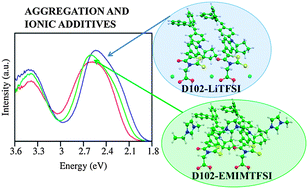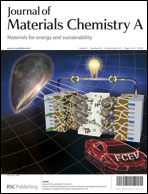Modeling the effect of ionic additives on the optical and electronic properties of a dye-sensitized TiO2 heterointerface: absorption, charge injection and aggregation†
Abstract
We present a joint experimental and theoretical study with the aim of investigating the individual effects of Li-TFSI and EMIM-TFSI additives on the optical and charge transfer properties of D102 dye in solution as well as at the dye-sensitized TiO2 interface. Experimental results show that while the spectral shifts are negligible for the dye in solution, when moving to the TiO2 film in air the addition of both lithium and EMIM salts clearly gives rise to a slight red-shift with the appearance of a lower-energy shoulder in the absorption spectrum. Computational modelling confirms the weak tendency to have stable dye/additive complexes in solution and predicts appreciable spectral red-shifts as a consequence of the interaction of the dye with Li+ and EMIM+ cations. We also predict a strong effect of the additives on the electronic coupling between the dye's LUMO and the TiO2 conduction band states, reflecting on the calculated injection rates. Further, by modeling the formation and the optical response of selected dye/additive aggregate models, we find a general broadening of the absorption band, accounting for the experimentally observed lower-energy shoulder in the D102 absorption spectrum recorded on TiO2 films where Li and EMIM salts are added.


 Please wait while we load your content...
Please wait while we load your content...